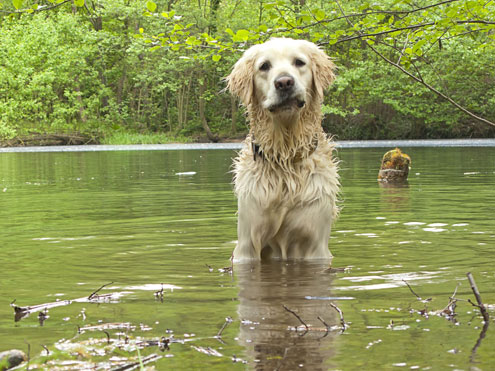By Tiffany L. Mitchener, DVM

What is leptospirosis? — Leptospirosis is a disease caused by a special type of bacteria called a spirochete. While there are over 200 subtypes of Leptospira interrogans that cause this disease in animals, there are only eight serovars, or subtypes, that can infect dogs.
How is leptospirosis transmitted? — Leptospirosis is most commonly transmitted when the eyes, nose, mouth, or skin with an open wound comes in contact with infected urine. It can come from contact with soil, food or bedding that has been urine-contaminated. Drinking infected water can also lead to infection. Leptospira can survive for months in the environment. Rarely, it is transmitted through a bite from an infected animal or by eating infected dead carcasses.
What are the clinical signs? — Once infection occurs, the bacterium spreads through the bloodstream. This can lead to fever, depression, loss of appetite, joint pain, muscle pain, and lethargy. The spirochete will often concentrate in the kidney where it can lead to inflammation and, ultimately, kidney failure. Ninety % of dogs with leptospirosis presenting to veterinarians are in acute kidney failure. In rare occasions, liver failure can also occur.
In these more extreme circumstances, symptoms may include excessive drinking, excessive urination, and jaundice. A few animals will have no symptoms at all or a very mild form of the disease. These animals often become “shedders” and will unknowingly shed the bacteria in their urine; these animals can contaminate the environment for months to years. Young animals seem to be more severely affected than older animals. The disease appears to be diagnosed more commonly from July to December. Large breed dogs in rural and suburban environments seem to be at highest risk.
According to the CDC — In humans, Leptospirosis can cause a wide range of symptoms, including: High fever, Headache, Chills, Muscle aches, Vomiting, Jaundice (yellow skin and eyes), Red eyes, Abdominal pain, Diarrhea, Rash. Many of these symptoms can be mistaken for other diseases and some infected persons may have no symptoms at all. Illness usually begins abruptly with fever, chills, headache, muscle aches, vomiting, or diarrhea. The illness lasts from a few days to 3 weeks or longer and recovery may take several months. If a second phase occurs, it is more severe; the person may have kidney or liver failure or meningitis. This phase is also called Weil’s disease.
Diagnosis and treatment of leptospirosis: — Leptospirosis can be diagnosed with serial antibody titers. A rising titer confirms infection. A single positive titer does not confirm the disease; it may be positive from a previous, subclinical infection or from vaccination. Once a diagnosis has been confirmed, the animal should be aggressively treated with a long course of antibiotics and supportive care. This may include IV fluids and hospitalization. It is imperative that the animal receives the entire course of antibiotics to prevent the development of a “shedder” situation as previously described. Urine of an infected animal should be very carefully cleaned up by a protected individual (gloves, gown, mask, etc.) with a disinfectant.
Prevention of leptospirosis: — Since this disease can so often have devastating consequences, it is very important to emphasize prevention. The first step is to minimize risk factors in our canine companions. Limit exposure to contaminated water: rivers, streams, lakes, and oceans. Do not allow pets to roam on rural properties. Limit exposure to wild animals, including in the backyard. Keep rodent populations under control.
Finally, vaccinate! — While the vaccination can only protect against four of the eight serovars known to commonly cause canine leptospirosis in the United States, it is still a key way to limit the disease. This vaccine is recommended for all dogs that are considered at higher risk of contracting leptospirosis due to their lifestyle. It is important to discuss with your veterinarian whether your dog is at risk for contracting leptospirosis and whether vaccination is recommended.
Leptospirosis infections are on the rise. Both humans and dogs can contract this disease. It can be transmitted directly from our canine companions to our human population. Therefore, it is very important to minimize our dog population’s likelihood of contracting the disease. I encourage all dog owners to discuss with their veterinarian how to minimize leptospirosis risk and to consider vaccinating against this dangerous disease.